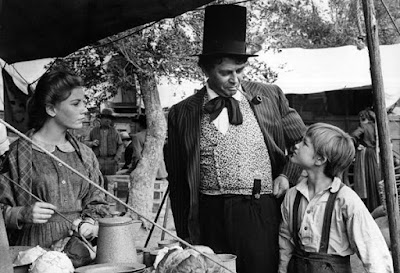To pay tribute to some of the talented individuals who worked behind-the-scenes in films, Silver Scenes has been releasing a series of posts entitled Behind-the-Screen : Masters from the Golden Age of Filmmaking. Today, I'll be highlighting Carl Jules Weyl, an extremely talented art director who worked primarily for Warner Brothers studios throughout the 1930s and 1940s.
The Stuttgart-born Weyl studied architecture in Berlin, Munich, and at the Ecole des Beaux-Arts in Paris before emigrating to America, where he worked as an architect throughout the 1920s. He designed such landmark Los Angeles buildings as the Hollywood Palace Theatre and the Brown Derby restaurant prior to landing a career as an art director in the early 1930s at Warner Brothers studios.
One of his first assignments was designing the sets for The Case of the Curious Bride ( 1935 ), an early Perry Mason mystery. It was a quick B-production featuring simple sets such as an apartment, court room, diner, and Mason's office, but it gave Weyl a chance to acquaint himself with creating architecture for film. Many more assignments for budget films and quick comedies would follow until 1937, when Weyl designed the sets for two better releases - Ready, Willing, and Able and Kid Galahad.
His consistent work at the studio led to Weyl being offered The Adventures of Robin Hood, giving him his first chance to experiment with the architecture of a different period. Weyl created several beautiful sets for this classic, including the interior of Nottingham castle with the now-famous circular stone staircase, and Sherwood Forest. Weyl romanticized this forest, which was filmed in Chico, California, by spray-painting the foliage green and adding a number of artificial rocks and trees.
While each and every one of his set designs were marvelous to look at, Weyl received but two Oscar nominations during his career, one of which was for The Adventures of Robin Hood.
 |
| The enormous Nottingham Castle interior set |
After Robin Hood, Carl Weyl worked primarily on designing sets for Warner Brother's leading players, notably for the films of Errol Flynn and Bette Davis. All This and Heaven Too, The Letter, The Great Lie, Watch on the Rhine, and The Corn is Green were all Bette Davis films that Weyl created sets for.
 |
| Interior of Miss Moffet's cottage in The Corn is Green |
Carl Jules Weyl varied his style for each different production, but a signature trademark of his work was that broad, almost medieval, strength of the frames on the structures that he designed. Almost all of the buildings he created for his films give the impression that they have been around for decades and will continue to stand for hundreds of years. Quite a feat to accomplish, considering many of these sets did not even have a backside to their walls!
The Corn is Green ( 1944 ) featured a particularly memorable country Tudor, with heavily plastered walls and oak beams. He created a similarly indestructible set for the interiors of the German locations seen in Desperate Journey ( 1942 ).
 |
| Rick's Cafe interior and the train station from Casablanca ( 1942 ) |
Undoubtedly, Casablanca remains Carl Weyl's most famous set, even though the set required very little new construction with many of the exteriors of "Rick's Cafe" being taken from older sets, and the interiors being kept to a minimum as producer Hal Wallis did not desire a lush set design. George James Hopkins worked as the set decorator for this picture, adding all of the smaller elements that made up the interior of the famous cafe.
During the 1940s, Weyl worked on many excellent dramas including Dr. Ehrlich's Magic Bullet ( 1940 ), Kings Row ( 1942 ), Yankee Doodle Dandy ( 1942 ), Mission to Moscow ( which earned him his second Oscar nomination ), Saratoga Trunk ( 1945 ), and The Big Sleep ( 1946 ).
 |
| Sets from Escape Me Never |




























